Analyzing Engineering and Scientific Literature
VerifiedAdded on 2020/04/01
|14
|3032
|32
AI Summary
This assignment requires a close analysis of provided research papers spanning various fields within engineering and science. The papers delve into subjects such as spline theory, geological evolution, system design, evolutionary algorithms, active learning in STEM, Green's functions, bioseparations, CRISPR-Cas9 gene editing, design research methods, systems science, casting solidification, and data-driven monitoring in batch processes. Students are expected to demonstrate their understanding of these concepts by carefully examining the provided texts.
Contribute Materials
Your contribution can guide someone’s learning journey. Share your
documents today.
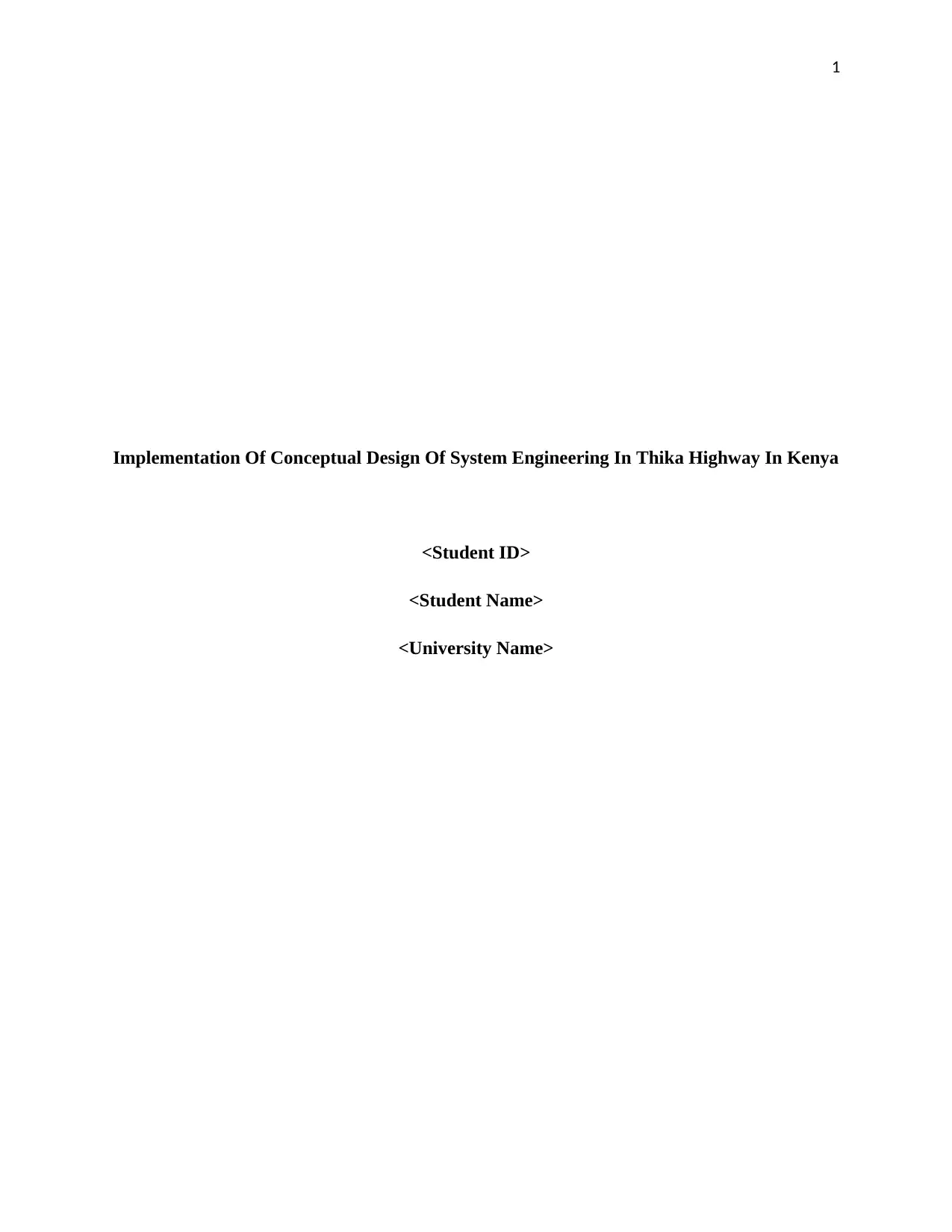
1
Implementation Of Conceptual Design Of System Engineering In Thika Highway In Kenya
<Student ID>
<Student Name>
<University Name>
Implementation Of Conceptual Design Of System Engineering In Thika Highway In Kenya
<Student ID>
<Student Name>
<University Name>
Secure Best Marks with AI Grader
Need help grading? Try our AI Grader for instant feedback on your assignments.
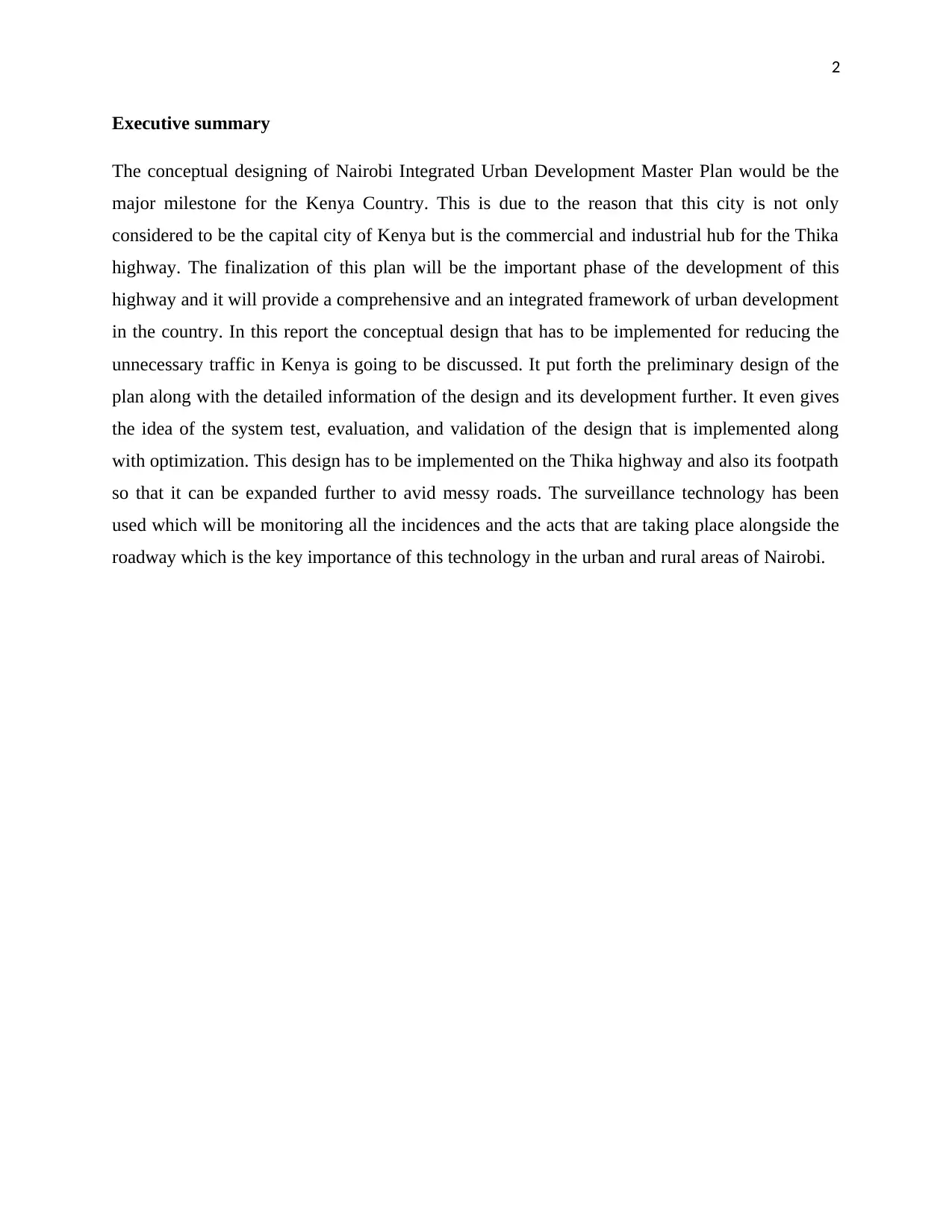
2
Executive summary
The conceptual designing of Nairobi Integrated Urban Development Master Plan would be the
major milestone for the Kenya Country. This is due to the reason that this city is not only
considered to be the capital city of Kenya but is the commercial and industrial hub for the Thika
highway. The finalization of this plan will be the important phase of the development of this
highway and it will provide a comprehensive and an integrated framework of urban development
in the country. In this report the conceptual design that has to be implemented for reducing the
unnecessary traffic in Kenya is going to be discussed. It put forth the preliminary design of the
plan along with the detailed information of the design and its development further. It even gives
the idea of the system test, evaluation, and validation of the design that is implemented along
with optimization. This design has to be implemented on the Thika highway and also its footpath
so that it can be expanded further to avid messy roads. The surveillance technology has been
used which will be monitoring all the incidences and the acts that are taking place alongside the
roadway which is the key importance of this technology in the urban and rural areas of Nairobi.
Executive summary
The conceptual designing of Nairobi Integrated Urban Development Master Plan would be the
major milestone for the Kenya Country. This is due to the reason that this city is not only
considered to be the capital city of Kenya but is the commercial and industrial hub for the Thika
highway. The finalization of this plan will be the important phase of the development of this
highway and it will provide a comprehensive and an integrated framework of urban development
in the country. In this report the conceptual design that has to be implemented for reducing the
unnecessary traffic in Kenya is going to be discussed. It put forth the preliminary design of the
plan along with the detailed information of the design and its development further. It even gives
the idea of the system test, evaluation, and validation of the design that is implemented along
with optimization. This design has to be implemented on the Thika highway and also its footpath
so that it can be expanded further to avid messy roads. The surveillance technology has been
used which will be monitoring all the incidences and the acts that are taking place alongside the
roadway which is the key importance of this technology in the urban and rural areas of Nairobi.
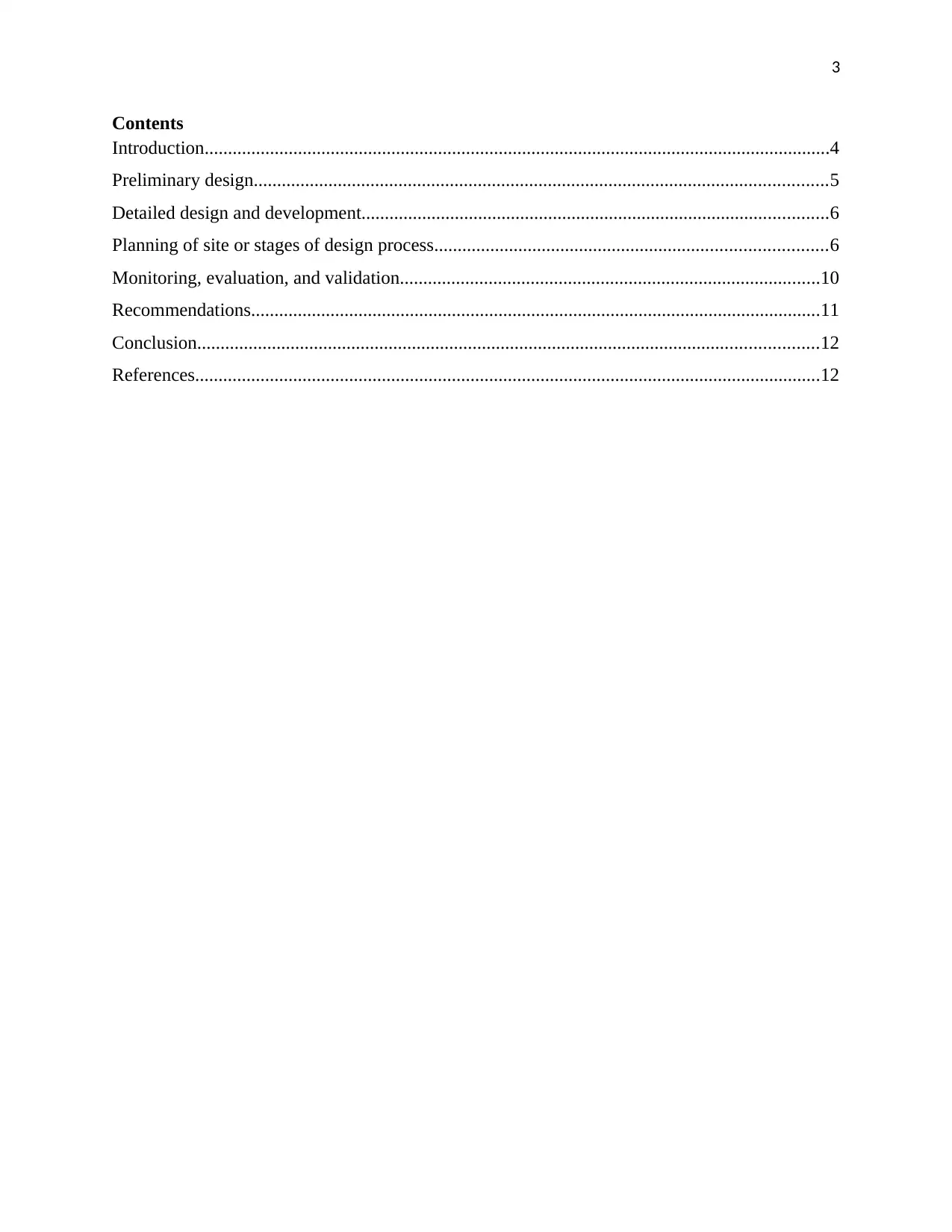
3
Contents
Introduction......................................................................................................................................4
Preliminary design...........................................................................................................................5
Detailed design and development....................................................................................................6
Planning of site or stages of design process....................................................................................6
Monitoring, evaluation, and validation..........................................................................................10
Recommendations..........................................................................................................................11
Conclusion.....................................................................................................................................12
References......................................................................................................................................12
Contents
Introduction......................................................................................................................................4
Preliminary design...........................................................................................................................5
Detailed design and development....................................................................................................6
Planning of site or stages of design process....................................................................................6
Monitoring, evaluation, and validation..........................................................................................10
Recommendations..........................................................................................................................11
Conclusion.....................................................................................................................................12
References......................................................................................................................................12
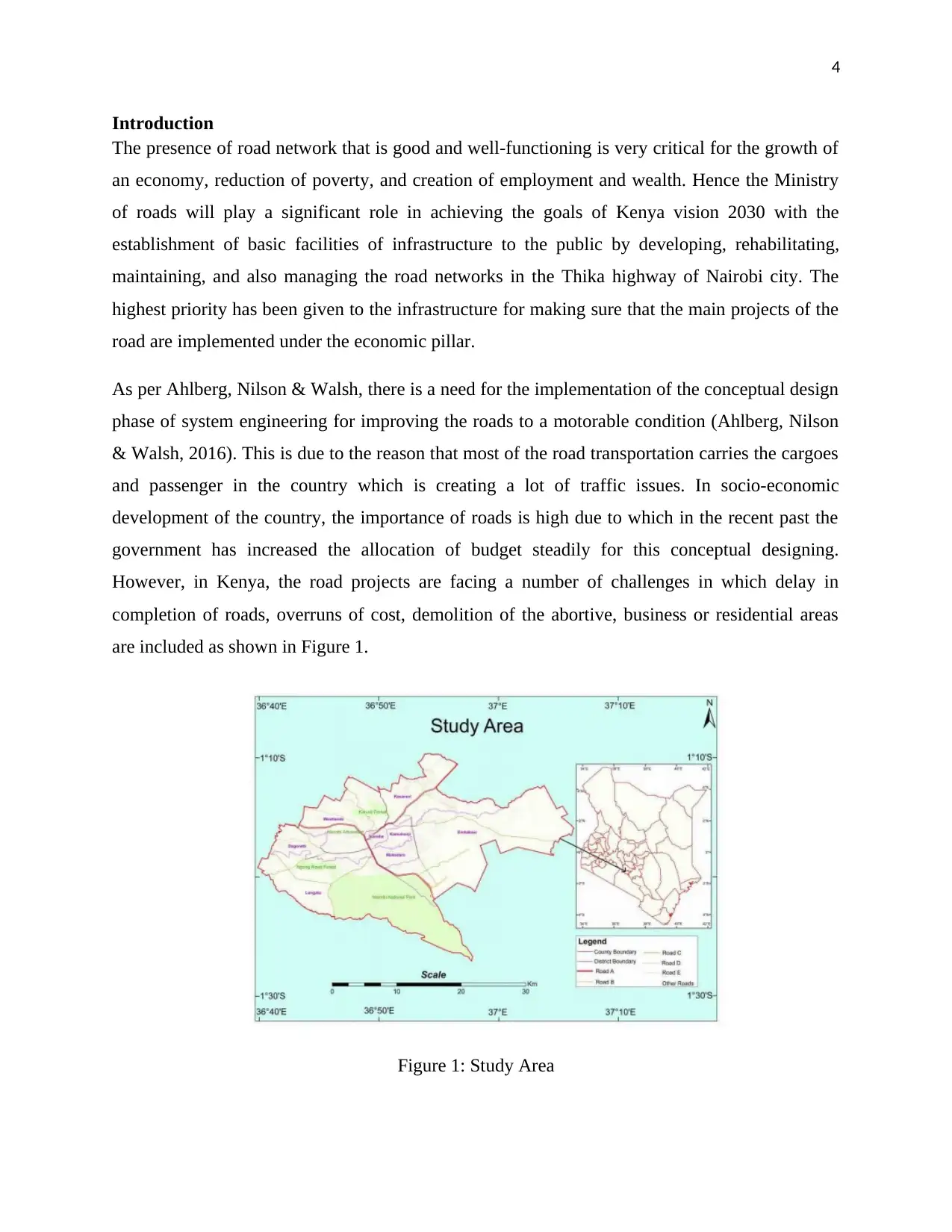
4
Introduction
The presence of road network that is good and well-functioning is very critical for the growth of
an economy, reduction of poverty, and creation of employment and wealth. Hence the Ministry
of roads will play a significant role in achieving the goals of Kenya vision 2030 with the
establishment of basic facilities of infrastructure to the public by developing, rehabilitating,
maintaining, and also managing the road networks in the Thika highway of Nairobi city. The
highest priority has been given to the infrastructure for making sure that the main projects of the
road are implemented under the economic pillar.
As per Ahlberg, Nilson & Walsh, there is a need for the implementation of the conceptual design
phase of system engineering for improving the roads to a motorable condition (Ahlberg, Nilson
& Walsh, 2016). This is due to the reason that most of the road transportation carries the cargoes
and passenger in the country which is creating a lot of traffic issues. In socio-economic
development of the country, the importance of roads is high due to which in the recent past the
government has increased the allocation of budget steadily for this conceptual designing.
However, in Kenya, the road projects are facing a number of challenges in which delay in
completion of roads, overruns of cost, demolition of the abortive, business or residential areas
are included as shown in Figure 1.
Figure 1: Study Area
Introduction
The presence of road network that is good and well-functioning is very critical for the growth of
an economy, reduction of poverty, and creation of employment and wealth. Hence the Ministry
of roads will play a significant role in achieving the goals of Kenya vision 2030 with the
establishment of basic facilities of infrastructure to the public by developing, rehabilitating,
maintaining, and also managing the road networks in the Thika highway of Nairobi city. The
highest priority has been given to the infrastructure for making sure that the main projects of the
road are implemented under the economic pillar.
As per Ahlberg, Nilson & Walsh, there is a need for the implementation of the conceptual design
phase of system engineering for improving the roads to a motorable condition (Ahlberg, Nilson
& Walsh, 2016). This is due to the reason that most of the road transportation carries the cargoes
and passenger in the country which is creating a lot of traffic issues. In socio-economic
development of the country, the importance of roads is high due to which in the recent past the
government has increased the allocation of budget steadily for this conceptual designing.
However, in Kenya, the road projects are facing a number of challenges in which delay in
completion of roads, overruns of cost, demolition of the abortive, business or residential areas
are included as shown in Figure 1.
Figure 1: Study Area
Secure Best Marks with AI Grader
Need help grading? Try our AI Grader for instant feedback on your assignments.
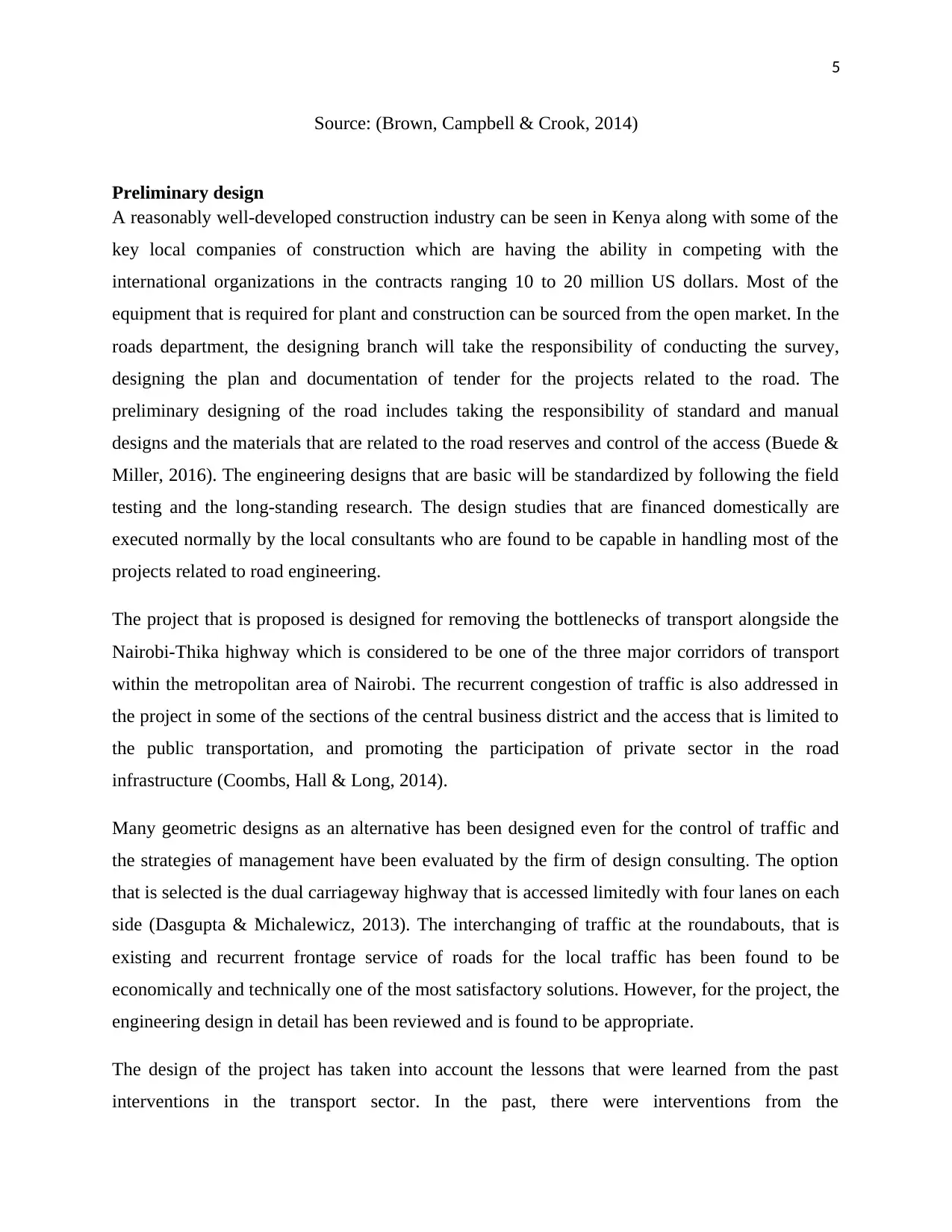
5
Source: (Brown, Campbell & Crook, 2014)
Preliminary design
A reasonably well-developed construction industry can be seen in Kenya along with some of the
key local companies of construction which are having the ability in competing with the
international organizations in the contracts ranging 10 to 20 million US dollars. Most of the
equipment that is required for plant and construction can be sourced from the open market. In the
roads department, the designing branch will take the responsibility of conducting the survey,
designing the plan and documentation of tender for the projects related to the road. The
preliminary designing of the road includes taking the responsibility of standard and manual
designs and the materials that are related to the road reserves and control of the access (Buede &
Miller, 2016). The engineering designs that are basic will be standardized by following the field
testing and the long-standing research. The design studies that are financed domestically are
executed normally by the local consultants who are found to be capable in handling most of the
projects related to road engineering.
The project that is proposed is designed for removing the bottlenecks of transport alongside the
Nairobi-Thika highway which is considered to be one of the three major corridors of transport
within the metropolitan area of Nairobi. The recurrent congestion of traffic is also addressed in
the project in some of the sections of the central business district and the access that is limited to
the public transportation, and promoting the participation of private sector in the road
infrastructure (Coombs, Hall & Long, 2014).
Many geometric designs as an alternative has been designed even for the control of traffic and
the strategies of management have been evaluated by the firm of design consulting. The option
that is selected is the dual carriageway highway that is accessed limitedly with four lanes on each
side (Dasgupta & Michalewicz, 2013). The interchanging of traffic at the roundabouts, that is
existing and recurrent frontage service of roads for the local traffic has been found to be
economically and technically one of the most satisfactory solutions. However, for the project, the
engineering design in detail has been reviewed and is found to be appropriate.
The design of the project has taken into account the lessons that were learned from the past
interventions in the transport sector. In the past, there were interventions from the
Source: (Brown, Campbell & Crook, 2014)
Preliminary design
A reasonably well-developed construction industry can be seen in Kenya along with some of the
key local companies of construction which are having the ability in competing with the
international organizations in the contracts ranging 10 to 20 million US dollars. Most of the
equipment that is required for plant and construction can be sourced from the open market. In the
roads department, the designing branch will take the responsibility of conducting the survey,
designing the plan and documentation of tender for the projects related to the road. The
preliminary designing of the road includes taking the responsibility of standard and manual
designs and the materials that are related to the road reserves and control of the access (Buede &
Miller, 2016). The engineering designs that are basic will be standardized by following the field
testing and the long-standing research. The design studies that are financed domestically are
executed normally by the local consultants who are found to be capable in handling most of the
projects related to road engineering.
The project that is proposed is designed for removing the bottlenecks of transport alongside the
Nairobi-Thika highway which is considered to be one of the three major corridors of transport
within the metropolitan area of Nairobi. The recurrent congestion of traffic is also addressed in
the project in some of the sections of the central business district and the access that is limited to
the public transportation, and promoting the participation of private sector in the road
infrastructure (Coombs, Hall & Long, 2014).
Many geometric designs as an alternative has been designed even for the control of traffic and
the strategies of management have been evaluated by the firm of design consulting. The option
that is selected is the dual carriageway highway that is accessed limitedly with four lanes on each
side (Dasgupta & Michalewicz, 2013). The interchanging of traffic at the roundabouts, that is
existing and recurrent frontage service of roads for the local traffic has been found to be
economically and technically one of the most satisfactory solutions. However, for the project, the
engineering design in detail has been reviewed and is found to be appropriate.
The design of the project has taken into account the lessons that were learned from the past
interventions in the transport sector. In the past, there were interventions from the
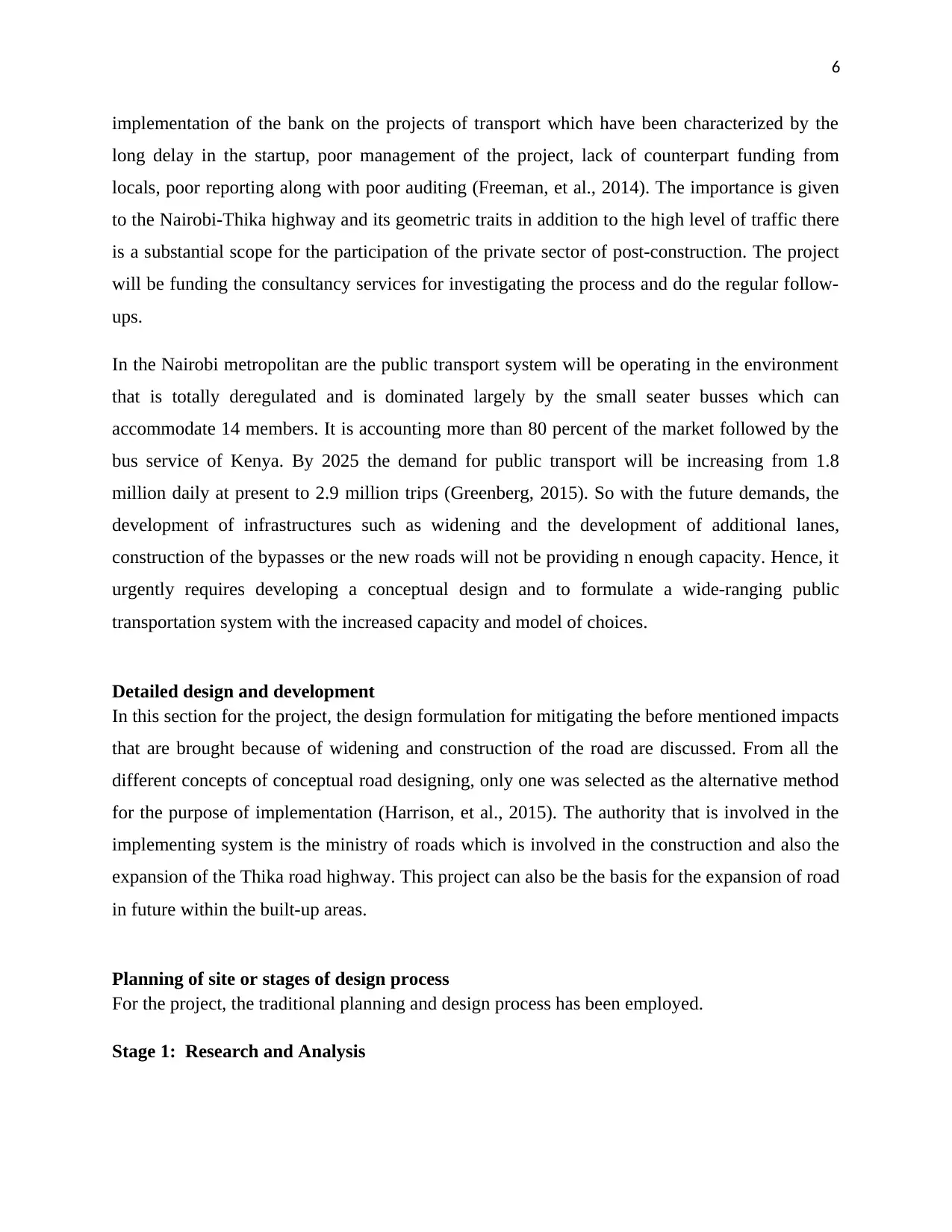
6
implementation of the bank on the projects of transport which have been characterized by the
long delay in the startup, poor management of the project, lack of counterpart funding from
locals, poor reporting along with poor auditing (Freeman, et al., 2014). The importance is given
to the Nairobi-Thika highway and its geometric traits in addition to the high level of traffic there
is a substantial scope for the participation of the private sector of post-construction. The project
will be funding the consultancy services for investigating the process and do the regular follow-
ups.
In the Nairobi metropolitan are the public transport system will be operating in the environment
that is totally deregulated and is dominated largely by the small seater busses which can
accommodate 14 members. It is accounting more than 80 percent of the market followed by the
bus service of Kenya. By 2025 the demand for public transport will be increasing from 1.8
million daily at present to 2.9 million trips (Greenberg, 2015). So with the future demands, the
development of infrastructures such as widening and the development of additional lanes,
construction of the bypasses or the new roads will not be providing n enough capacity. Hence, it
urgently requires developing a conceptual design and to formulate a wide-ranging public
transportation system with the increased capacity and model of choices.
Detailed design and development
In this section for the project, the design formulation for mitigating the before mentioned impacts
that are brought because of widening and construction of the road are discussed. From all the
different concepts of conceptual road designing, only one was selected as the alternative method
for the purpose of implementation (Harrison, et al., 2015). The authority that is involved in the
implementing system is the ministry of roads which is involved in the construction and also the
expansion of the Thika road highway. This project can also be the basis for the expansion of road
in future within the built-up areas.
Planning of site or stages of design process
For the project, the traditional planning and design process has been employed.
Stage 1: Research and Analysis
implementation of the bank on the projects of transport which have been characterized by the
long delay in the startup, poor management of the project, lack of counterpart funding from
locals, poor reporting along with poor auditing (Freeman, et al., 2014). The importance is given
to the Nairobi-Thika highway and its geometric traits in addition to the high level of traffic there
is a substantial scope for the participation of the private sector of post-construction. The project
will be funding the consultancy services for investigating the process and do the regular follow-
ups.
In the Nairobi metropolitan are the public transport system will be operating in the environment
that is totally deregulated and is dominated largely by the small seater busses which can
accommodate 14 members. It is accounting more than 80 percent of the market followed by the
bus service of Kenya. By 2025 the demand for public transport will be increasing from 1.8
million daily at present to 2.9 million trips (Greenberg, 2015). So with the future demands, the
development of infrastructures such as widening and the development of additional lanes,
construction of the bypasses or the new roads will not be providing n enough capacity. Hence, it
urgently requires developing a conceptual design and to formulate a wide-ranging public
transportation system with the increased capacity and model of choices.
Detailed design and development
In this section for the project, the design formulation for mitigating the before mentioned impacts
that are brought because of widening and construction of the road are discussed. From all the
different concepts of conceptual road designing, only one was selected as the alternative method
for the purpose of implementation (Harrison, et al., 2015). The authority that is involved in the
implementing system is the ministry of roads which is involved in the construction and also the
expansion of the Thika road highway. This project can also be the basis for the expansion of road
in future within the built-up areas.
Planning of site or stages of design process
For the project, the traditional planning and design process has been employed.
Stage 1: Research and Analysis
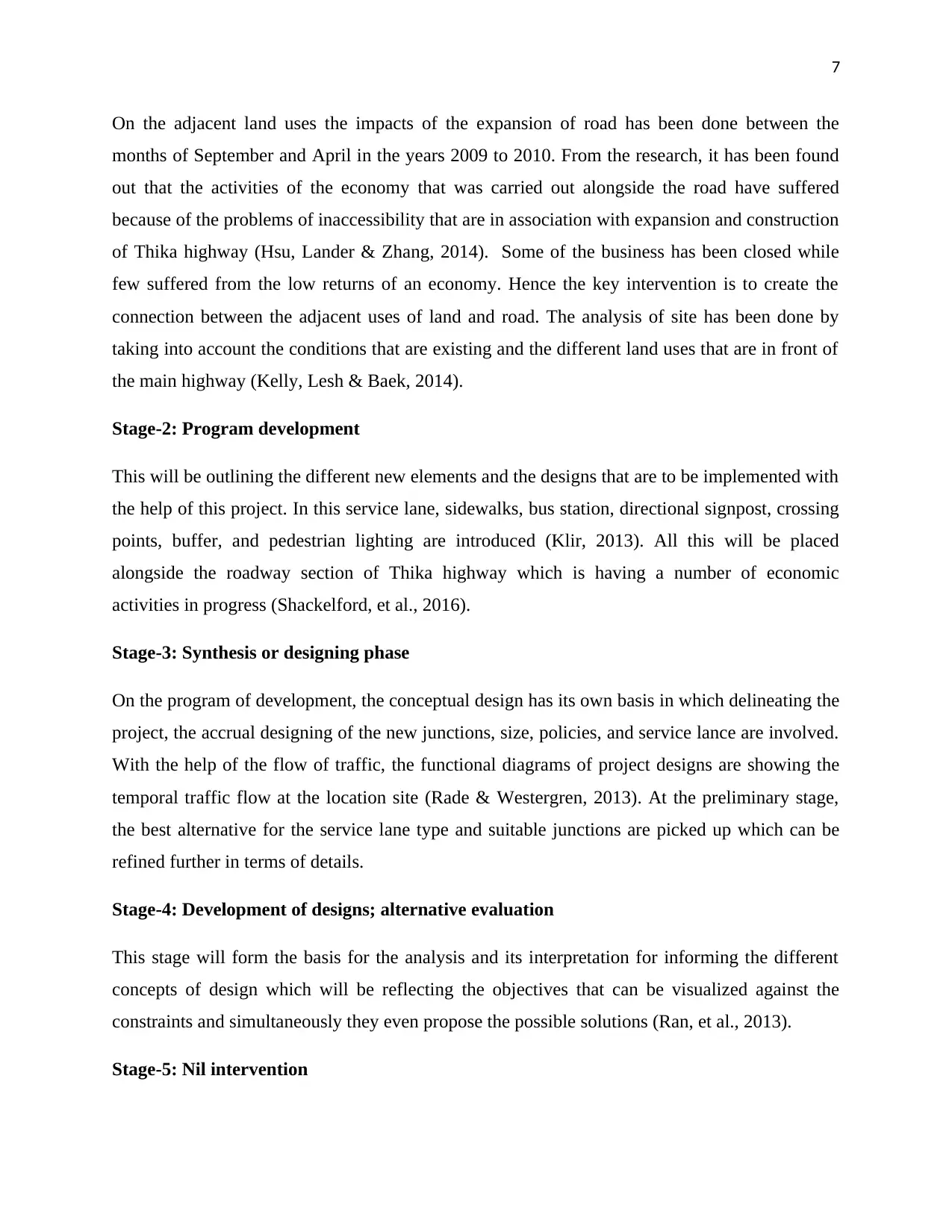
7
On the adjacent land uses the impacts of the expansion of road has been done between the
months of September and April in the years 2009 to 2010. From the research, it has been found
out that the activities of the economy that was carried out alongside the road have suffered
because of the problems of inaccessibility that are in association with expansion and construction
of Thika highway (Hsu, Lander & Zhang, 2014). Some of the business has been closed while
few suffered from the low returns of an economy. Hence the key intervention is to create the
connection between the adjacent uses of land and road. The analysis of site has been done by
taking into account the conditions that are existing and the different land uses that are in front of
the main highway (Kelly, Lesh & Baek, 2014).
Stage-2: Program development
This will be outlining the different new elements and the designs that are to be implemented with
the help of this project. In this service lane, sidewalks, bus station, directional signpost, crossing
points, buffer, and pedestrian lighting are introduced (Klir, 2013). All this will be placed
alongside the roadway section of Thika highway which is having a number of economic
activities in progress (Shackelford, et al., 2016).
Stage-3: Synthesis or designing phase
On the program of development, the conceptual design has its own basis in which delineating the
project, the accrual designing of the new junctions, size, policies, and service lance are involved.
With the help of the flow of traffic, the functional diagrams of project designs are showing the
temporal traffic flow at the location site (Rade & Westergren, 2013). At the preliminary stage,
the best alternative for the service lane type and suitable junctions are picked up which can be
refined further in terms of details.
Stage-4: Development of designs; alternative evaluation
This stage will form the basis for the analysis and its interpretation for informing the different
concepts of design which will be reflecting the objectives that can be visualized against the
constraints and simultaneously they even propose the possible solutions (Ran, et al., 2013).
Stage-5: Nil intervention
On the adjacent land uses the impacts of the expansion of road has been done between the
months of September and April in the years 2009 to 2010. From the research, it has been found
out that the activities of the economy that was carried out alongside the road have suffered
because of the problems of inaccessibility that are in association with expansion and construction
of Thika highway (Hsu, Lander & Zhang, 2014). Some of the business has been closed while
few suffered from the low returns of an economy. Hence the key intervention is to create the
connection between the adjacent uses of land and road. The analysis of site has been done by
taking into account the conditions that are existing and the different land uses that are in front of
the main highway (Kelly, Lesh & Baek, 2014).
Stage-2: Program development
This will be outlining the different new elements and the designs that are to be implemented with
the help of this project. In this service lane, sidewalks, bus station, directional signpost, crossing
points, buffer, and pedestrian lighting are introduced (Klir, 2013). All this will be placed
alongside the roadway section of Thika highway which is having a number of economic
activities in progress (Shackelford, et al., 2016).
Stage-3: Synthesis or designing phase
On the program of development, the conceptual design has its own basis in which delineating the
project, the accrual designing of the new junctions, size, policies, and service lance are involved.
With the help of the flow of traffic, the functional diagrams of project designs are showing the
temporal traffic flow at the location site (Rade & Westergren, 2013). At the preliminary stage,
the best alternative for the service lane type and suitable junctions are picked up which can be
refined further in terms of details.
Stage-4: Development of designs; alternative evaluation
This stage will form the basis for the analysis and its interpretation for informing the different
concepts of design which will be reflecting the objectives that can be visualized against the
constraints and simultaneously they even propose the possible solutions (Ran, et al., 2013).
Stage-5: Nil intervention
Paraphrase This Document
Need a fresh take? Get an instant paraphrase of this document with our AI Paraphraser
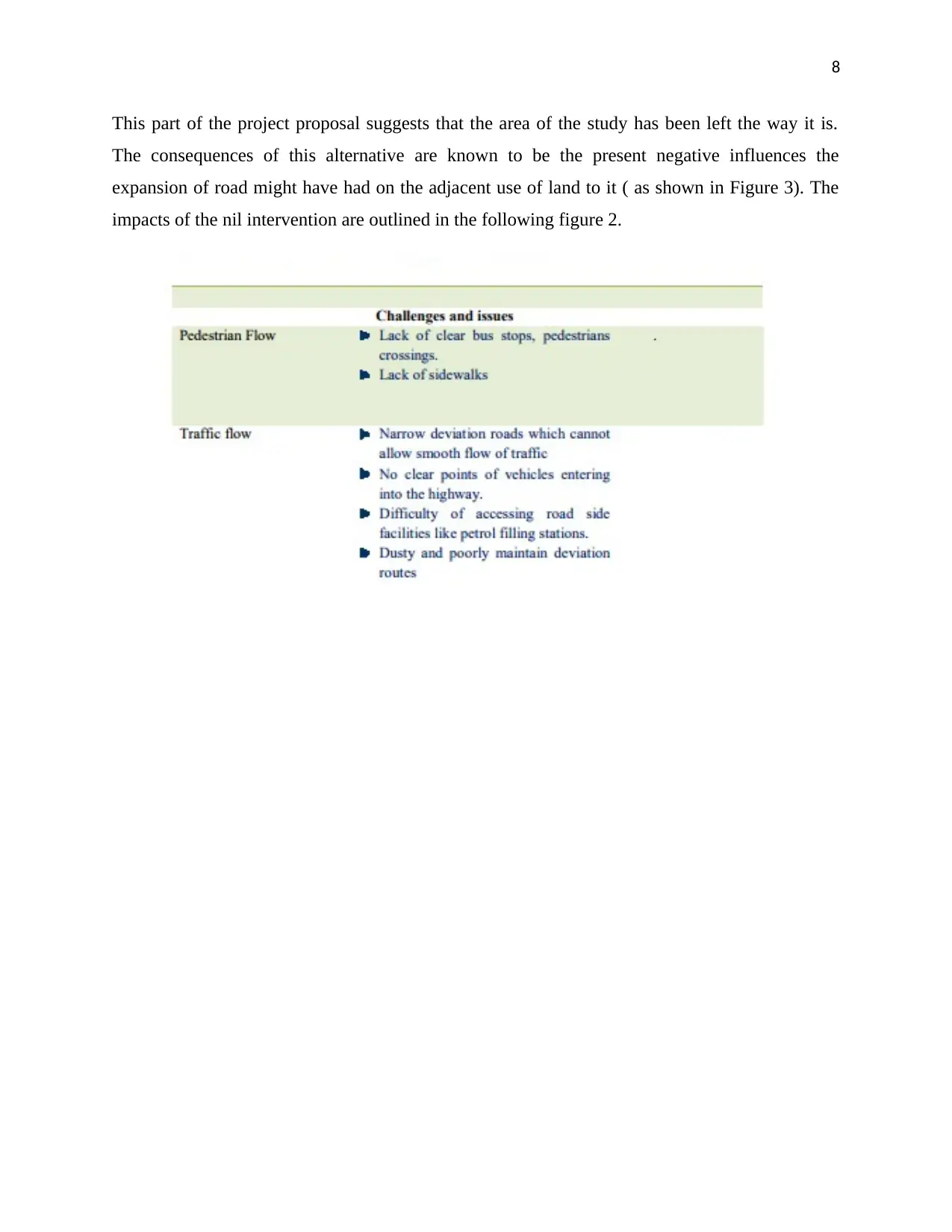
8
This part of the project proposal suggests that the area of the study has been left the way it is.
The consequences of this alternative are known to be the present negative influences the
expansion of road might have had on the adjacent use of land to it ( as shown in Figure 3). The
impacts of the nil intervention are outlined in the following figure 2.
This part of the project proposal suggests that the area of the study has been left the way it is.
The consequences of this alternative are known to be the present negative influences the
expansion of road might have had on the adjacent use of land to it ( as shown in Figure 3). The
impacts of the nil intervention are outlined in the following figure 2.
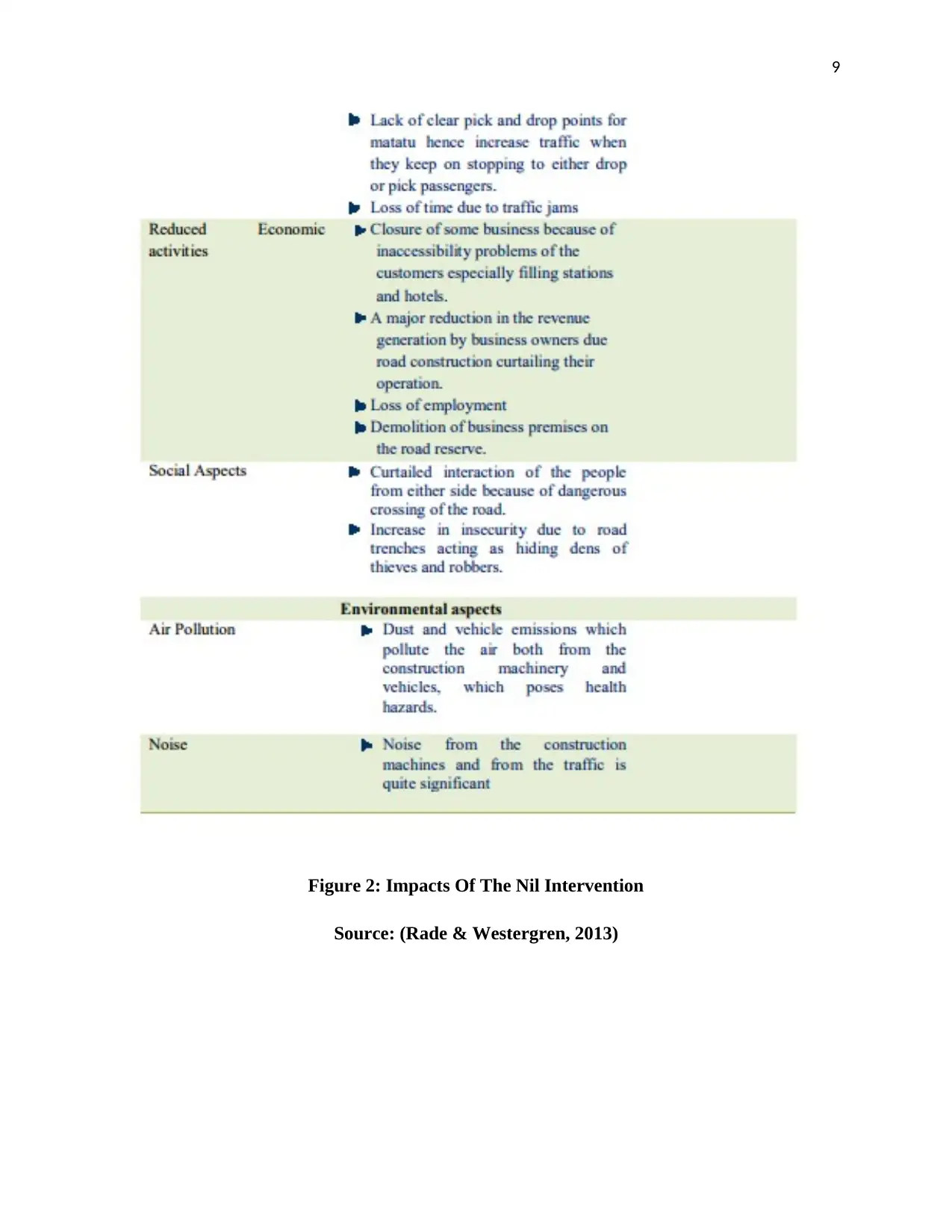
9
Figure 2: Impacts Of The Nil Intervention
Source: (Rade & Westergren, 2013)
Figure 2: Impacts Of The Nil Intervention
Source: (Rade & Westergren, 2013)
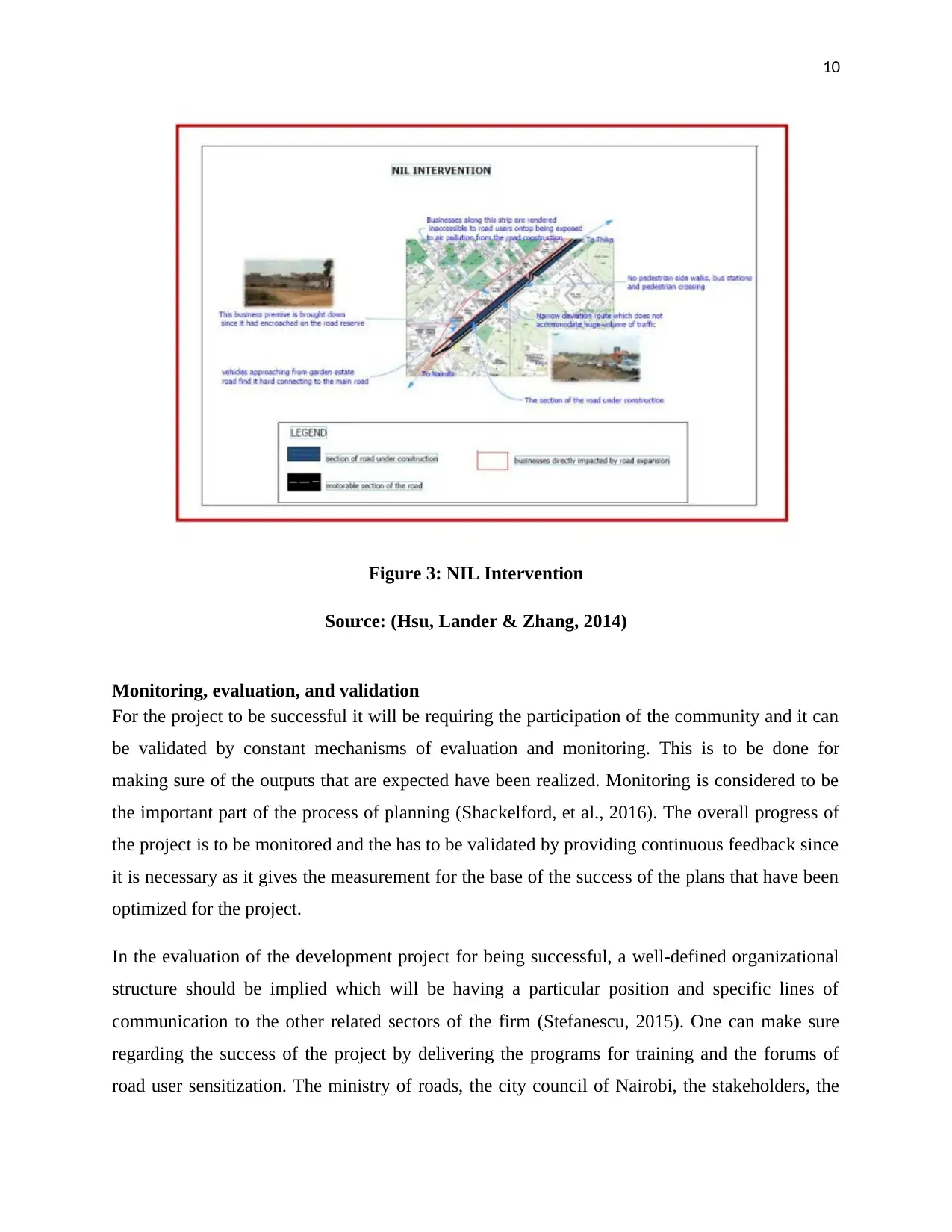
10
Figure 3: NIL Intervention
Source: (Hsu, Lander & Zhang, 2014)
Monitoring, evaluation, and validation
For the project to be successful it will be requiring the participation of the community and it can
be validated by constant mechanisms of evaluation and monitoring. This is to be done for
making sure of the outputs that are expected have been realized. Monitoring is considered to be
the important part of the process of planning (Shackelford, et al., 2016). The overall progress of
the project is to be monitored and the has to be validated by providing continuous feedback since
it is necessary as it gives the measurement for the base of the success of the plans that have been
optimized for the project.
In the evaluation of the development project for being successful, a well-defined organizational
structure should be implied which will be having a particular position and specific lines of
communication to the other related sectors of the firm (Stefanescu, 2015). One can make sure
regarding the success of the project by delivering the programs for training and the forums of
road user sensitization. The ministry of roads, the city council of Nairobi, the stakeholders, the
Figure 3: NIL Intervention
Source: (Hsu, Lander & Zhang, 2014)
Monitoring, evaluation, and validation
For the project to be successful it will be requiring the participation of the community and it can
be validated by constant mechanisms of evaluation and monitoring. This is to be done for
making sure of the outputs that are expected have been realized. Monitoring is considered to be
the important part of the process of planning (Shackelford, et al., 2016). The overall progress of
the project is to be monitored and the has to be validated by providing continuous feedback since
it is necessary as it gives the measurement for the base of the success of the plans that have been
optimized for the project.
In the evaluation of the development project for being successful, a well-defined organizational
structure should be implied which will be having a particular position and specific lines of
communication to the other related sectors of the firm (Stefanescu, 2015). One can make sure
regarding the success of the project by delivering the programs for training and the forums of
road user sensitization. The ministry of roads, the city council of Nairobi, the stakeholders, the
Secure Best Marks with AI Grader
Need help grading? Try our AI Grader for instant feedback on your assignments.
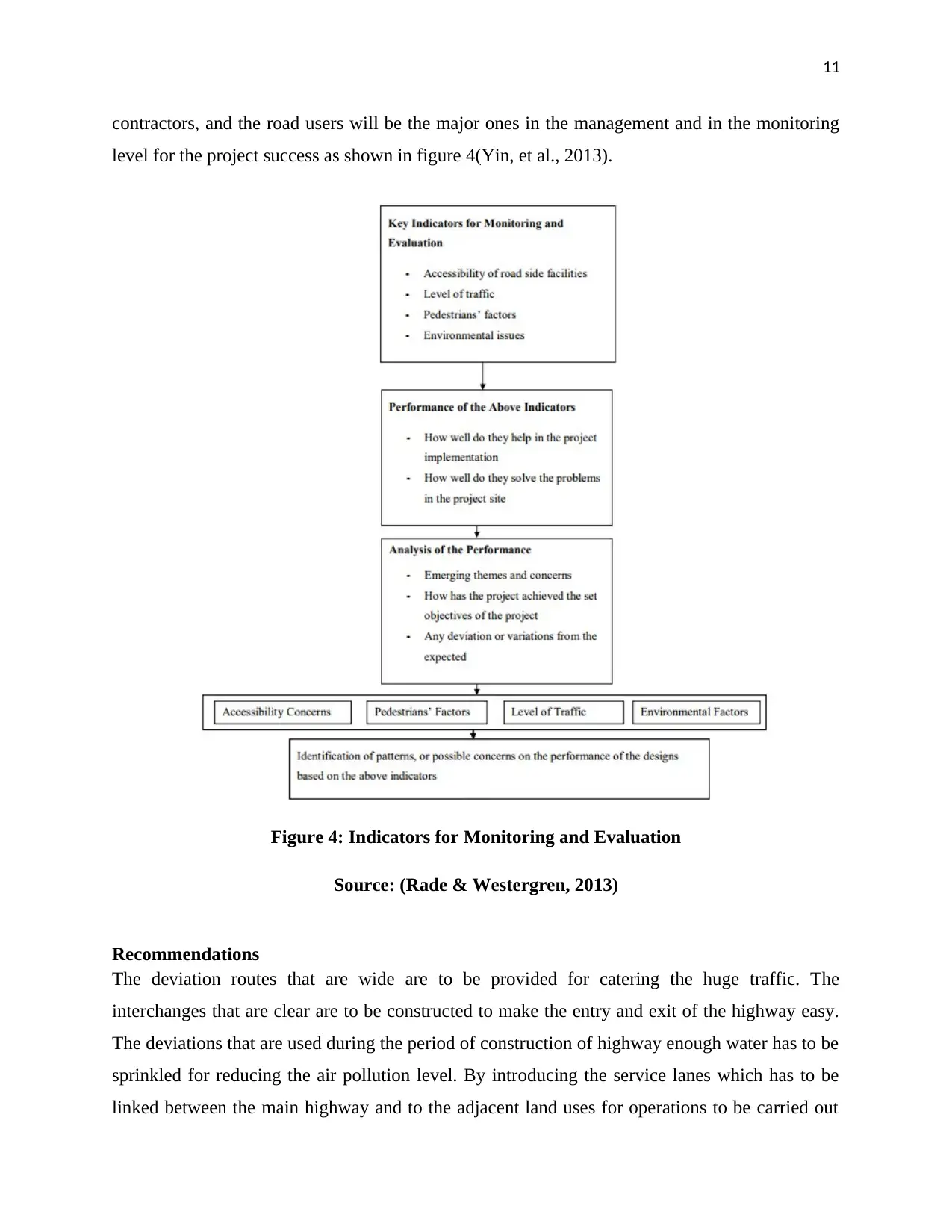
11
contractors, and the road users will be the major ones in the management and in the monitoring
level for the project success as shown in figure 4(Yin, et al., 2013).
Figure 4: Indicators for Monitoring and Evaluation
Source: (Rade & Westergren, 2013)
Recommendations
The deviation routes that are wide are to be provided for catering the huge traffic. The
interchanges that are clear are to be constructed to make the entry and exit of the highway easy.
The deviations that are used during the period of construction of highway enough water has to be
sprinkled for reducing the air pollution level. By introducing the service lanes which has to be
linked between the main highway and to the adjacent land uses for operations to be carried out
contractors, and the road users will be the major ones in the management and in the monitoring
level for the project success as shown in figure 4(Yin, et al., 2013).
Figure 4: Indicators for Monitoring and Evaluation
Source: (Rade & Westergren, 2013)
Recommendations
The deviation routes that are wide are to be provided for catering the huge traffic. The
interchanges that are clear are to be constructed to make the entry and exit of the highway easy.
The deviations that are used during the period of construction of highway enough water has to be
sprinkled for reducing the air pollution level. By introducing the service lanes which has to be
linked between the main highway and to the adjacent land uses for operations to be carried out
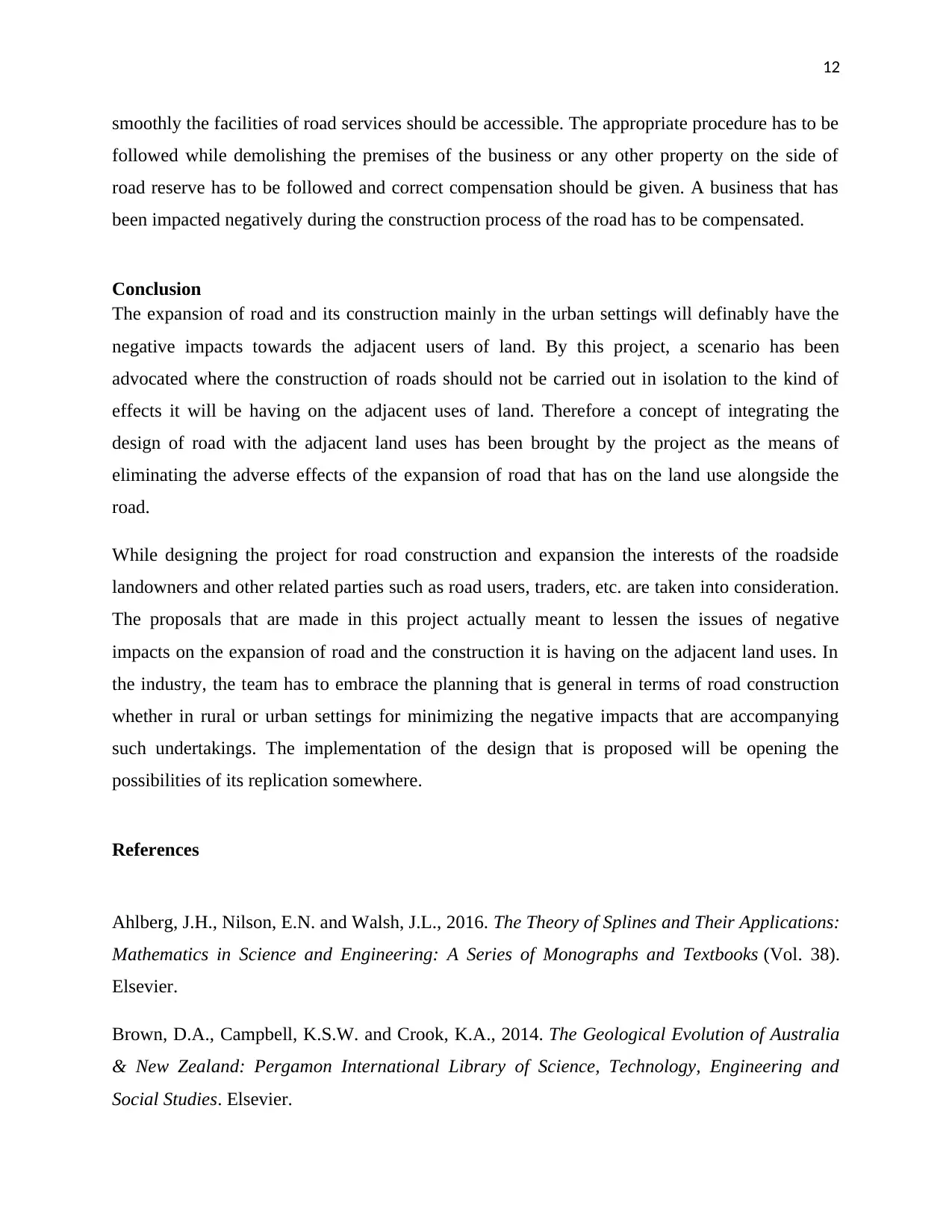
12
smoothly the facilities of road services should be accessible. The appropriate procedure has to be
followed while demolishing the premises of the business or any other property on the side of
road reserve has to be followed and correct compensation should be given. A business that has
been impacted negatively during the construction process of the road has to be compensated.
Conclusion
The expansion of road and its construction mainly in the urban settings will definably have the
negative impacts towards the adjacent users of land. By this project, a scenario has been
advocated where the construction of roads should not be carried out in isolation to the kind of
effects it will be having on the adjacent uses of land. Therefore a concept of integrating the
design of road with the adjacent land uses has been brought by the project as the means of
eliminating the adverse effects of the expansion of road that has on the land use alongside the
road.
While designing the project for road construction and expansion the interests of the roadside
landowners and other related parties such as road users, traders, etc. are taken into consideration.
The proposals that are made in this project actually meant to lessen the issues of negative
impacts on the expansion of road and the construction it is having on the adjacent land uses. In
the industry, the team has to embrace the planning that is general in terms of road construction
whether in rural or urban settings for minimizing the negative impacts that are accompanying
such undertakings. The implementation of the design that is proposed will be opening the
possibilities of its replication somewhere.
References
Ahlberg, J.H., Nilson, E.N. and Walsh, J.L., 2016. The Theory of Splines and Their Applications:
Mathematics in Science and Engineering: A Series of Monographs and Textbooks (Vol. 38).
Elsevier.
Brown, D.A., Campbell, K.S.W. and Crook, K.A., 2014. The Geological Evolution of Australia
& New Zealand: Pergamon International Library of Science, Technology, Engineering and
Social Studies. Elsevier.
smoothly the facilities of road services should be accessible. The appropriate procedure has to be
followed while demolishing the premises of the business or any other property on the side of
road reserve has to be followed and correct compensation should be given. A business that has
been impacted negatively during the construction process of the road has to be compensated.
Conclusion
The expansion of road and its construction mainly in the urban settings will definably have the
negative impacts towards the adjacent users of land. By this project, a scenario has been
advocated where the construction of roads should not be carried out in isolation to the kind of
effects it will be having on the adjacent uses of land. Therefore a concept of integrating the
design of road with the adjacent land uses has been brought by the project as the means of
eliminating the adverse effects of the expansion of road that has on the land use alongside the
road.
While designing the project for road construction and expansion the interests of the roadside
landowners and other related parties such as road users, traders, etc. are taken into consideration.
The proposals that are made in this project actually meant to lessen the issues of negative
impacts on the expansion of road and the construction it is having on the adjacent land uses. In
the industry, the team has to embrace the planning that is general in terms of road construction
whether in rural or urban settings for minimizing the negative impacts that are accompanying
such undertakings. The implementation of the design that is proposed will be opening the
possibilities of its replication somewhere.
References
Ahlberg, J.H., Nilson, E.N. and Walsh, J.L., 2016. The Theory of Splines and Their Applications:
Mathematics in Science and Engineering: A Series of Monographs and Textbooks (Vol. 38).
Elsevier.
Brown, D.A., Campbell, K.S.W. and Crook, K.A., 2014. The Geological Evolution of Australia
& New Zealand: Pergamon International Library of Science, Technology, Engineering and
Social Studies. Elsevier.
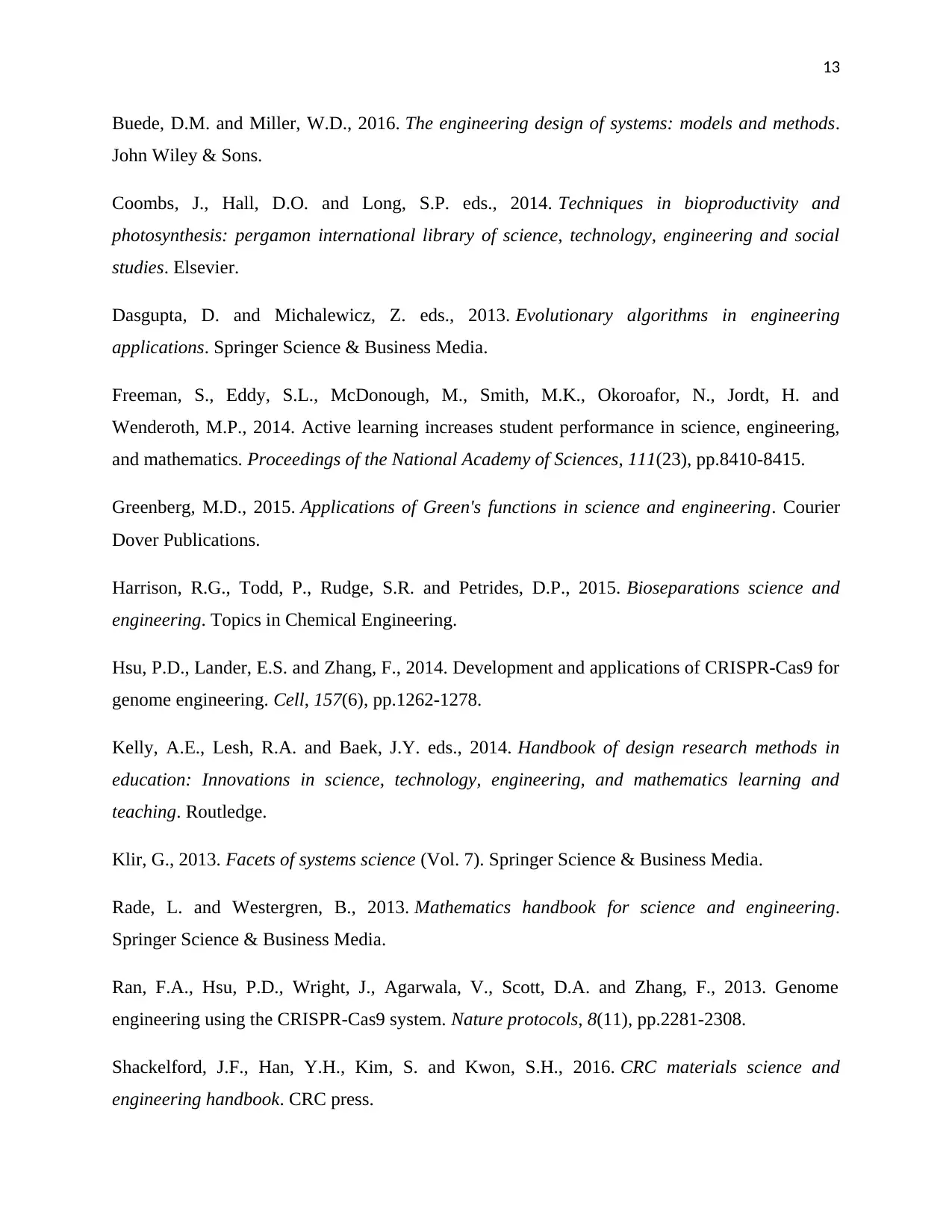
13
Buede, D.M. and Miller, W.D., 2016. The engineering design of systems: models and methods.
John Wiley & Sons.
Coombs, J., Hall, D.O. and Long, S.P. eds., 2014. Techniques in bioproductivity and
photosynthesis: pergamon international library of science, technology, engineering and social
studies. Elsevier.
Dasgupta, D. and Michalewicz, Z. eds., 2013. Evolutionary algorithms in engineering
applications. Springer Science & Business Media.
Freeman, S., Eddy, S.L., McDonough, M., Smith, M.K., Okoroafor, N., Jordt, H. and
Wenderoth, M.P., 2014. Active learning increases student performance in science, engineering,
and mathematics. Proceedings of the National Academy of Sciences, 111(23), pp.8410-8415.
Greenberg, M.D., 2015. Applications of Green's functions in science and engineering. Courier
Dover Publications.
Harrison, R.G., Todd, P., Rudge, S.R. and Petrides, D.P., 2015. Bioseparations science and
engineering. Topics in Chemical Engineering.
Hsu, P.D., Lander, E.S. and Zhang, F., 2014. Development and applications of CRISPR-Cas9 for
genome engineering. Cell, 157(6), pp.1262-1278.
Kelly, A.E., Lesh, R.A. and Baek, J.Y. eds., 2014. Handbook of design research methods in
education: Innovations in science, technology, engineering, and mathematics learning and
teaching. Routledge.
Klir, G., 2013. Facets of systems science (Vol. 7). Springer Science & Business Media.
Rade, L. and Westergren, B., 2013. Mathematics handbook for science and engineering.
Springer Science & Business Media.
Ran, F.A., Hsu, P.D., Wright, J., Agarwala, V., Scott, D.A. and Zhang, F., 2013. Genome
engineering using the CRISPR-Cas9 system. Nature protocols, 8(11), pp.2281-2308.
Shackelford, J.F., Han, Y.H., Kim, S. and Kwon, S.H., 2016. CRC materials science and
engineering handbook. CRC press.
Buede, D.M. and Miller, W.D., 2016. The engineering design of systems: models and methods.
John Wiley & Sons.
Coombs, J., Hall, D.O. and Long, S.P. eds., 2014. Techniques in bioproductivity and
photosynthesis: pergamon international library of science, technology, engineering and social
studies. Elsevier.
Dasgupta, D. and Michalewicz, Z. eds., 2013. Evolutionary algorithms in engineering
applications. Springer Science & Business Media.
Freeman, S., Eddy, S.L., McDonough, M., Smith, M.K., Okoroafor, N., Jordt, H. and
Wenderoth, M.P., 2014. Active learning increases student performance in science, engineering,
and mathematics. Proceedings of the National Academy of Sciences, 111(23), pp.8410-8415.
Greenberg, M.D., 2015. Applications of Green's functions in science and engineering. Courier
Dover Publications.
Harrison, R.G., Todd, P., Rudge, S.R. and Petrides, D.P., 2015. Bioseparations science and
engineering. Topics in Chemical Engineering.
Hsu, P.D., Lander, E.S. and Zhang, F., 2014. Development and applications of CRISPR-Cas9 for
genome engineering. Cell, 157(6), pp.1262-1278.
Kelly, A.E., Lesh, R.A. and Baek, J.Y. eds., 2014. Handbook of design research methods in
education: Innovations in science, technology, engineering, and mathematics learning and
teaching. Routledge.
Klir, G., 2013. Facets of systems science (Vol. 7). Springer Science & Business Media.
Rade, L. and Westergren, B., 2013. Mathematics handbook for science and engineering.
Springer Science & Business Media.
Ran, F.A., Hsu, P.D., Wright, J., Agarwala, V., Scott, D.A. and Zhang, F., 2013. Genome
engineering using the CRISPR-Cas9 system. Nature protocols, 8(11), pp.2281-2308.
Shackelford, J.F., Han, Y.H., Kim, S. and Kwon, S.H., 2016. CRC materials science and
engineering handbook. CRC press.
Paraphrase This Document
Need a fresh take? Get an instant paraphrase of this document with our AI Paraphraser

14
Stefanescu, D., 2015. Science and engineering of casting solidification. Springer.
Yin, S., Ding, S.X., Abandan Sari, A.H. and Hao, H., 2013. Data-driven monitoring for
stochastic systems and its application on batch process. International Journal of Systems
Science, 44(7), pp.1366-1376.
Stefanescu, D., 2015. Science and engineering of casting solidification. Springer.
Yin, S., Ding, S.X., Abandan Sari, A.H. and Hao, H., 2013. Data-driven monitoring for
stochastic systems and its application on batch process. International Journal of Systems
Science, 44(7), pp.1366-1376.
1 out of 14
Related Documents
Your All-in-One AI-Powered Toolkit for Academic Success.
+13062052269
info@desklib.com
Available 24*7 on WhatsApp / Email
![[object Object]](/_next/static/media/star-bottom.7253800d.svg)
Unlock your academic potential
© 2024 | Zucol Services PVT LTD | All rights reserved.





